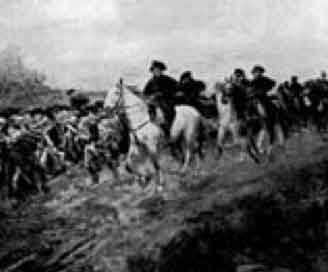Revolutionary War (War for Independence)
1775 – 1783
The War for Independence, when viewed in proportion to contemporary population and wealth, destroyed more lives and property than any American war since then, with the exception of the Civil War. It also lasted longer than all other American wars, except for the Vietnam conflict. While Americans often remember the Revolution in relatively straightforward terms-as a struggle for independence between the American patriots on the one hand and the British mother country on the other-the war was in fact much more complex. Fighting against the American patriots were British and German regular troops, Indians allied with the British, and American militias loyal to the British crown. Roughly forty percent of the population remained uncommitted to either side.
Fighting on the patriot side were allied Indian tribes as well as French military forces, who supported the rebel cause both in the United States and in Europe by engaging the British in a colonial fight for independence that ultimately became worldwide in scope. British officers who had served in the colonies during the French and Indian War (1754-1763) believed the Americans would prove to be “leaderless, lazy, and militarily ineffectual.” They expected high rates of desertion among the American forces, and “assumed a lack of toughness in the rebels–who they thought–would collapse at the first application of force.” In this, of course, the British were mistaken.

We still remember the Revolutionary War for its many outstanding examples of American heroism and perseverance, perhaps the most famous of which remains the harrowing winter encampment at Valley Forge, Pennsylvania, where the Continental Army under George Washington suffered terribly under conditions of extreme privation. Having been recently defeated by the British at the Battle of the Brandywine, Philadelphia, Germantown and then the Delaware River, Washington’s bedraggled army continued to train throughout the winter and emerged in the spring “tougher and better organized than ever.”

Fought on land by regular, militia and guerrilla forces, and at sea (with the French navy providing invaluable assistance to the Americans on the Atlantic as well as the Mediterranean), the War for Independence wore out all its principal participants long before the fighting came to an end in the Spring of 1782. American victory–and with it independence–seemed constantly in jeopardy, and yet by war’s end, the British government faced “severe financial peril and a public sick of war.”
AMERICAN CASUALTIES
Between 25,000 and 70,000 American Patriots died during active military service.[1] Of these, approximately 6,800 were killed in battle, while at least 17,000 died from disease. The majority of the latter died while prisoners of war of the British, mostly in the prison ships in New York Harbor.[2] If the upper limit of 70,000 is accepted as the total net loss for the Patriots, it would make the conflict proportionally deadlier than the American Civil War.[3] Uncertainty arises due to the difficulties in accurately calculating the number of those who succumbed to disease, as it is estimated at least 10,000 died in 1776 alone.[3] The number of Patriots seriously wounded or disabled by the war has been conservatively estimated from 8,500 to 25,000.
[1] Howard H. Peckham, ed., The Toll of Independence: Engagements and Battle Casualties of the American Revolution (Chicago: University of Chicago Press, 1974)
[2] Burrows, Edwin G. (Fall 2008). “Patriots or Terrorists”. American Heritage, 58 (5) Archived from the original on March 23, 2013. Retrieved November 29, 2014
[3] Duncan, Louis C., Medical Men in the American Revolution (1931)
RECOMMENDED READING
All books are available at our Museum Library which is open to the public every Thursday from 10am to 4pm.
The Blackwell Encyclopedia of the American Revolution
by Jack P. Greene and J. R. Pole
The Glorious Cause: the American Revolution, 1763-1789
by Robert Middlekauff
The War of American Independence: Military Attitudes, Policies and Practice, 1763-1789
by Don Higginbotham
Faces of Revolution: Personalities and Themes in the Struggle for American Independence
by Bernard Bailyn
